Ceylon special forces. The main enemy is the "Tamil Tigers"
In 1948, after granting independence to Ceylon, the creation of the country's regular armed forces began. The Ceylon army was created with considerable assistance from the UK. The ground forces were created in 1949, the Navy in 1950 and the Air Force in 1951. However, for a long time the Ceylon armed forces developed at a slow pace, which was explained by the absence of serious external threats. Ceylon was always in good relations with India and had a defense agreement with the UK, which minimized the possibility of external threats. Therefore, for a long time, the Ceylon army served only to assist the police in the protection of public order. After the attempted coup d'état in 1962, the country's leadership reduced military spending and reduced the number of army units.
In many ways, it was precisely the weakness of the country's armed forces that led to the fact that the government was not able to effectively withstand internal risks. In 1971, the guerrilla war against the government was launched by Marxist rebels from the People’s Liberation Front, and in 1972, the Tamil separatists became more active. Since then and already more than forty years in the territory of Sri Lanka, with varying success and periodic truces, there has been a bloody civil war between government forces and rebels from the Tigers of Tamil Elam Liberation Organization. The confrontation is based on ethnic contradictions between the Singhals, the Buddhists who make up the majority of the island’s population, and the black Tamils, the South Indian Dravidian people who profess Hinduism and inhabit the northern areas of the island.
Army Commandos
It was the intensification of the Tamil separatists in the north of Sri Lanka that was one of the main reasons for the accelerated creation of quite numerous and well-trained special forces within the armed forces of this island state. As in many other countries in South and Southeast Asia, in Sri Lanka, special forces are divided between the branches of the Armed Forces. The ground forces, air forces and naval forces have their own special forces, as well as law enforcement agencies. The most famous and numerous special forces of the Sri Lankan Armed Forces is the Sri Lankan Army Commando Regiment. It was created in the image and likeness of the legendary British special forces SAS (Special Air Service). In 1977, Lieutenant General Jeddah Perera announced the need to create a special anti-terrorism unit as part of the Sri Lankan armed forces. First of all, there was a question about the personnel reserve of the unit being formed. It was decided to select the best candidates from among the military personnel of the Lankan army who served in the tank corps, artillery, engineering troops, light infantry.
9 February 1978 began the first commando training course, which was attended by 26 volunteers - officers and sergeants from various units of the Lankan army. A squadron of commandos led by Major Peyris and Captain Handapangoda was formed in the Gemuna Vach camp. The first squadron of commandos received a special anti-terrorism training in the direction of the fight against hijacking aircraft on the basis of the Special Air Service of Great Britain. Somewhat later, the Sri Lankan commandos underwent parachute training in Indian Agra. 4 December 1980 squadron commandos were transferred to a new camp in Ganemulla, and in 1981 for the first time the special forces took part in an antiterrorist operation against the Tamil insurgents on the Jaffna peninsula. Also, the squadron is used to serve in the security department of the President of Sri Lanka. Thus, the main function of the army special forces of the armed forces of Sri Lanka is anti-terrorism, understood in the difficult military-political situation in the country, as the fight against the insurgent movement of the Tamil separatists.
Recall that the Tamil rebels are a very serious opponent. Unlike many other rebel organizations in Asian, African and Latin American countries, the Tamil tigers have significant financial resources, receiving assistance from the multi-million Tamil diaspora in the United States, Canada, Britain, Malaysia, and Singapore. The tiger positions are also strong among the peasant population in the Tamil regions of Sri Lanka. The Tigers of the Liberation of Tamil Eelam is characterized by a high level of fanaticism, including readiness for the use of suicide bombers. In fact, Tamil tigers are a full-fledged and well-equipped “forest army”, which is armed with modern weapons and even uses Aviation (a unique case in the history of world partisan movements). Naturally, confrontation with the Tamil tigers requires an appropriate level of equipment and training of government troops.
The special units of the Lankan army became one of the main tools to counter the terrorist attacks of the Tamil rebels. Commando units were tasked to carry out reconnaissance and sabotage operations in the rear of the enemy. The commandos organized ambushes and raids on groups of Tamil rebels, forcing the latter’s commanders to weaken offensive activity. After all, the large-sized units of the Tamil tigers after the commando attacks were sent to provide protection for the rear, thereby reducing the number of combat units that fought against the Lankan army. Most successful commando operations are still kept secret. Among the well-known raids were the attack on Mallaka on the Jaffna peninsula in 1990, the raid on Kulam province in 1993. In June-July, 2007 commando units participated in the seizure of the rocky plateau of Tora Bora, during which 200 Tamil tigers were killed in a clash with government forces. In addition to offensive operations, commandos have repeatedly participated in reconnaissance missions. Thus, in 2001, the commandos participated in the rescue of eight soldiers, led by Lieutenant Udesh Rathnayaka, who were surrounded by Tamil tigers in the Vanni area. The commando reinforcements led by Major Shanaka Rathnauke arrived on four helicopters and, despite the bad weather, conducted a brilliant rescue operation.
The main organizational unit of the commando regiment are teams for 20 military personnel, which in turn are divided into assault units numbering from four to eight special forces. Sri Lankan commandos are trained in the UK, India, Pakistan and Israel. In Sri Lanka itself, there is a commando training school in Ganemulla. At present, the commandos of the Lankan army, although they are called "the old-fashioned" regiment, but in reality represent a brigade-type unit, consisting of four regiments.
The regiment of special purpose of the Lankan army
Another no less famous and elite special forces unit of the Lankan army is the Special Forces Regiment. It was founded in 1986 and since then is considered one of the most secret and effective special forces of its kind. Like the Commando Regiment, in reality it is a brigade comprising several regiments. In 1985, the training of servicemen who responded as volunteers to the special forces service was started. Initially, thirty-eight people underwent a training course — officers, sergeants, and soldiers of the Lankan army, who were fit to serve in special forces in their physical and psychological characteristics. The special forces regiment was assigned the task of committing sabotage operations in the enemy's rear - the Tamil tigers. Initially, the special forces regiment was called the “Battle Tracker Command”, but later it was renamed the Special Service Group, then the Rapid Deployment Force, and finally, in December 1988, the Sri Lankan Special Task Regiment. At present, the special forces of the Lankan army consists of a regimental center, a special-purpose brigade, three battalions, a regimental staff battalion, and a military special forces school. The military units are trained at the bases of the Pakistani army.
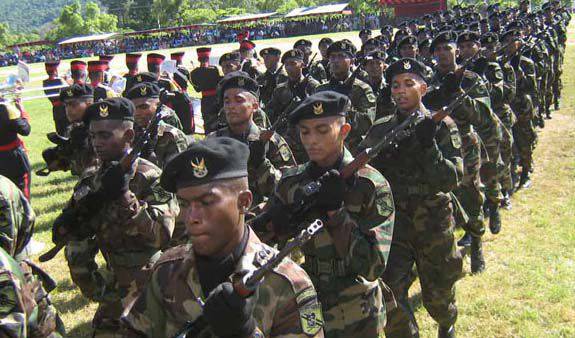
All candidates for service in the regiment of special forces are most seriously selected, and then proceed to training in the training center. Jungle survival techniques, sniper training, reconnaissance, ammunition and explosives are being studied. Each commando must be able to survive in the jungle in any conditions, including being there without special equipment and weapons. Particular emphasis is placed on physical fitness. Special forces recruits must be able to make an eighty-kilometer throw in twelve hours without equipment and eight kilometers in forty minutes with equipment. Also recruits undergo mountaineering training and are trained in scuba diving. All special forces annually undergo monthly refresher courses. Service in spetsnaz does not have a specific time frame - soldiers and officers serve, as long as they have physical strength and psychological readiness to accomplish the assigned tasks. In the event of a deterioration in their physical or psychological condition, they depart from the special forces in the usual units of the Lankan army.
The structure of the Lankan special forces is as follows. The first regiment of special forces includes a combat motorcycle squadron, whose fighters move on off-road motorcycles. The purpose of this unit is to deliver lightning strikes on the enemy, followed by rapid retreat on the territory controlled by government forces. The second special forces regiment, created in 1994, is a full-fledged battalion of four combat squadrons. It includes highly skilled underwater swimmers trained to land at the coast and conduct underwater and near-water operations. The third special forces regiment was created in 1996 year as a division of combat swimmers and operates in close cooperation with the special forces of the naval forces of Sri Lanka. The regiment also performs tasks for long-range airborne reconnaissance. In 2008, a fourth special forces regiment was created, and from 2009 to 2012. The fifth regiment of special forces of the Lankan army existed. 16 April 2012 was created a special squadron, designed to free the hostages and combat terrorist attacks in urban environments.
The emblem of the Sri Lankan special forces depicts an eagle, considered a symbol of courage and military qualities. The eagle's excellent vision emphasizes the ability of the special forces to quickly search for a target, while the powerful wings emphasize the mobility of the movement. The curved claws symbolize the weapon, and the hooked beak - the destruction of the target. Four arrows symbolize the structure of the regiment, consisting of four divisions, and also hint at the lower units of the special forces - teams of four soldiers in each.

Air and sea special forces of Sri Lanka
Own special forces got in 2003 g. And the Air Force of Sri Lanka. They include the Regiment of Special Forces of the Air Force, established on the basis of a squadron of defense of air bases. The reason for the creation of a military special forces was the attack on the airport of the Bandaranaike Tamil Tigers. Aviation special forces are tasked with protecting the air bases and protecting them as rapid deployment forces, conducting search and rescue operations and rescuing aircraft crews shot down or crashed, guarding senior air force officers, and participating in emergency response. Aviation Special Forces fighters are trained in the special forces school in Madurai, where they learn the basics of rescue operations, explosive disposal, survival in the jungle and on the water, fire fighting.
In 1993, the Sri Lankan Navy, based on the British Special Boat Service, created the Special Boat Squadron, considered the most elite unit of the Sri Lankan fleet. A special boat squadron is a combat swimmer. The main purpose of this special unit is to conduct a wide range of marine reconnaissance, sabotage, anti-sabotage and anti-terrorism measures. Fighting swimmers move on small boats, making rapid landings on the coast, mining and clearing sea and coastal objects. In conducting land operations, combat swimmers cooperate with the commando regiment and the special purpose regiment of the Sri Lank ground forces, with units of the naval forces and ground forces. The priority tasks of the unit include: conducting covert maritime reconnaissance, small operations in support of military operations on the coast, fighting terrorism at sea, attacking targets, naval intelligence, guarding senior officers of the Sri Lanka Navy.
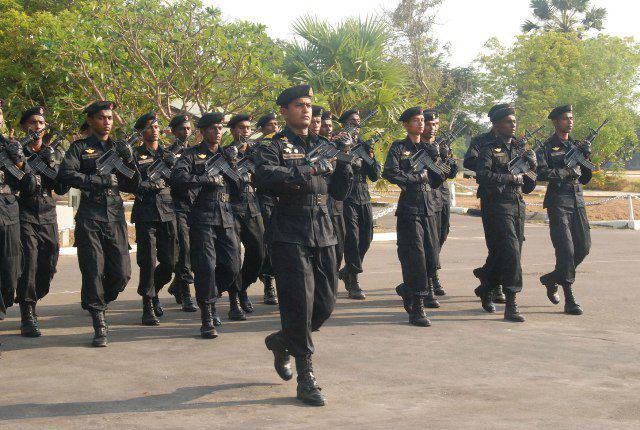
18 January 1993 was created by a naval special forces unit of two officers and 76 sailors under the command of Lieutenant Ravindra Vijegunarathne. After completing the special training course, the first special boat squadron was formed as part of the 25 military. And in November 1993, the naval special forces had to take part in the first combat operation - the defense of the naval base in Punerin. Later, the naval special forces took part in a whole series of large-scale operations of the Lankan army against the Tamil tigers. The main object of military attacks of the naval special forces are currently the ships and boats of the Tamil tigers, as well as the objects of the marine infrastructure controlled by the Tamil rebels.
Special Forces on guard of order
Sri Lanka Police Service has its own special forces. Established in 1983, the Special Task Force is designed to combat terrorism and conduct counterinsurgency punitive operations. Despite the fact that the organizational special unit is part of the Sri Lankan police, it is largely approximated in its structure and quality of preparation for the army special forces. The main task of the group is to oppose the Tamil tigers. The unit is based in the Eastern Province of Sri Lanka, where the resistance of the Tamil rebels was suppressed, as well as in the districts of Manar and Vavuniya. Several police special forces units are stationed in the capital, Colombo, and perform tasks to ensure the safety of important political figures, protect public order and prevent terrorism at major events. In addition, the Sri Lankan police special forces are actively involved in international events. So, in 2008, the Sri Lankan special forces took part in ensuring the security of the Olympic Games in Beijing.
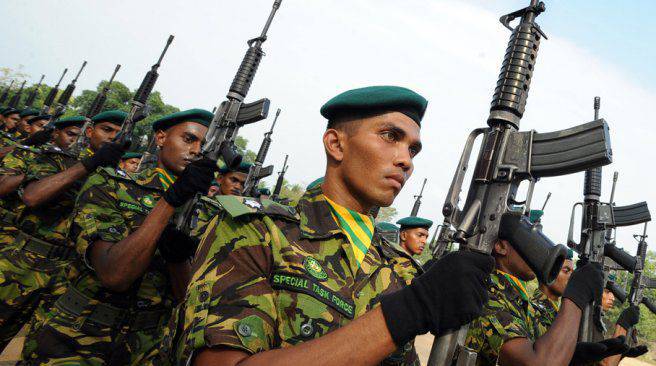
The police special forces include active police officers who have received special training in the units of the army special forces and who master the art of surviving and waging war in the jungle. In 42 kilometers south of Colombo, in Kalutara, a police special forces training center operates. The first special forces platoons were deployed in the northern provinces of Sri Lanka in order to strengthen local police stations and fight against the Tamil rebels. Back in 1980-s. training of the Sri Lankan police special forces was carried out according to the methods of the British CAC. SAS instructors trained Lankan Special Forces at the Police College in Katukurund. Currently, the Task Force has one of the best training centers in South and Southeast Asia. Since 1984, the training of the police special forces of Sri Lanka is being carried out by the instructor of the Israeli special services "Shin Bet".
From 1987, the police special forces took an active part in the civil war in Sri Lanka. Special forces units were deployed in Battikaloa district, where they were able to regain full control of the central government over the territory. In 2007, the police special forces managed to seize the 15 of the Tamil rebel camps, including Stanley, considered the most important base of the Tamil tigers, the Bagayadi base, where local and foreign food and medical supplies were stored, the Janak base, where the uniform identical to the uniform of the Lankan army was made. After the Stanley base was captured, the special forces officers managed to find trucks and a motorcycle loaded with explosives, with the help of which the Tamil tigers planned to launch suicide attacks in the capital, Colombo. Also, the police special forces managed to seize a large amount of weapons, including ammunition and anti-personnel mines, vehicles, radios, generators, boats and tents, as well as a fully equipped hospital donated by Tamil tigers by an international organization. However, Sri Lankan and international human rights organizations accuse police special forces of repeated violations of human rights, including the practice of extrajudicial killings of Tamil men. It is alleged that, around 30, Tamil men in 1994 were killed without trial by police special forces and thrown into rivers and lakes around the capital Colombo.
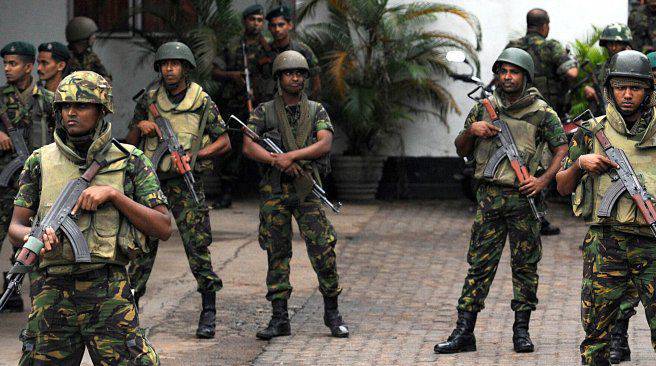
Speaking about the special divisions of the Sri Lankan law enforcement agencies, one can not fail to draw attention to the two units that perform the functions of protecting the highest officials of Sri Lanka. The Security Division of the President of Sri Lanka is part of the Security Division of the President of Sri Lanka and is headed by the Deputy Inspector General of the Police of Sri Lanka. Service in this unit are carried by specially trained police and army officers. They perform tasks for the personal protection of the President of the country, the protection of his residence and the office.
In addition to the police, the Sri Lankan president has recently been involved in the security of the Sri Lankan army. A Presidential Guard was formed, for which officers, sergeants, and soldiers from other Sri Lankan armies are selected. First of all, soldiers from the Sri Lankan Tank Corps, as well as Sri Lanka Light Infantry, the Sinha Regiment and the Gadzhab Regiment are selected for service on the presidential guard. Soldiers perform the functions of protecting the residence of the President of the country, called the "Temple of the trees." The Presidential Guard functions autonomously from another security unit of the head of state - the Police Security Division. Perhaps, by doing so, the Sri Lankan leadership is being protected against a possible military coup - the conspiracy of the military is neutralized by the police, and the conspiracy of the police by the military.
The Prime Minister’s Security Division is a division of the Prime Minister’s Security Division. The Security Department of the Prime Minister, in turn, is a member of the Sri Lankan Police Service and performs the personal protection functions of the head of the Lankan government. The department is headed by a chief with the rank of Deputy Inspector General of Police. For the first time, police officers took over the security service of the Prime Minister of Ceylon after the creation of this post in 1947. Regular police officers, who initially did not have special training, were chosen to protect the office of the Prime Minister and his residence. After Prime Minister Bandaranaike was assassinated at his residence, the need for specially trained bodyguards was actualized. We can assume that this sad event gave impetus to the creation of the Lankan security units in their modern form. In 1990, the Prime Minister’s Security Division was created to include specially trained police officers.
"Brigade of Demons" - the secret division of saboteurs
One of the most secret elite special forces of the Lankan army is the Long Range Reconnaissance Patrol (LRRP), also known as the Makhasokhon Brigade. Makhasokhon - one of the demonic characters of Sinhalese national mythology, respectively, the literal translation of this name means "Brigade of demons." The unit specializes in reconnaissance and sabotage operations deep in the rear of the enemy. During the civil war in Sri Lanka, the "demons" committed several murders of the highest commanders of the Tamil tigers, and on the territory controlled by the rebels. The activity of the unit is kept in deep secrecy and the exact size and structure of the "demons" are unknown to either the government of Sri Lanka or the command of the armed forces. The command of the special unit is the military intelligence directorate of the Lankan army. The special forces include commandos and special forces regiments of the Lankan army, as well as former Tamil tigers who have gone over to the side of government forces, and militants of Tamil armed groups that are ideological and practical opponents of Tamil tigers. The use of Tamil-controlled militants in the activities of special forces allows them to perform effective reconnaissance and sabotage operations, and, if necessary, to issue special forces for Tamil tigers, provoking internal clashes in the ranks of the enemy.
Special Forces fighters are trained at US Special Forces bases. Special Forces officers are taught to work in small groups that are thrown into the territory controlled by the enemy. More often than not, the unit fighters make roadside ambushes and attack the tuples of prominent Tamil rebel commanders. As a result of such attacks, they were killed: September 6 2001 - Colonel of the Tigers of the Liberation of Tamil Eelam Shankar, who commanded the air forces of the Tamil tigers; Lieutenant Colonel Gangai Amaran, who commanded the Tamil Tigers naval forces; Major Mano, Chief of Communications of the Tamil Tigers, and Major Sathijaselan, Chief Artillery Specialist. In May, the 2001, the special forces, attacked the car of the former political leader of the Tamil Tigers, Tamilselvan, but the latter was not in the car, which allowed him to avoid death.
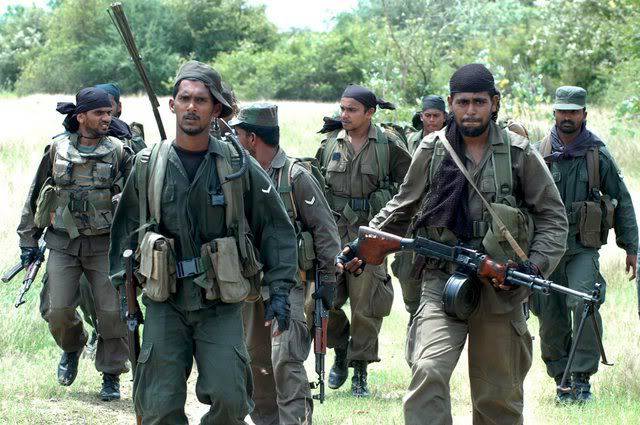
The excessive secrecy surrounding the activities of the special forces "demons" often becomes the cause of misunderstandings. So, 2 January 2002, a police special forces led by police superintendent Kulaciri Udugampola attacked the headquarters of the “Brigade of Demons” in the suburbs of Colombo. Special Forces officers accused of preparing an assassination attempt on the leaders of the government of the United National Army, six people, including the unit commander Captain Neelam, were arrested. Also, the police confiscated a significant amount of weapons and explosives. Reports of a police operation appeared in most media outlets. The command of the armed forces had no choice but to declassify the existence of a special unit. Lt. Gen. Lionel Balagallla, commander of the Lankan army, made a statement in which he spoke about the true nature and tasks of the "Brigade of Demons." After the intervention of the Minister of Defense Tilak Marapana, the arrested special forces were released. A little later, a special investigation of the incident took place, which resulted in the activities of the police officers who carried out the arrests of special forces, was regarded as treacherous, threatening the national security of Sri Lanka and aiding the Tamil rebel movement. However, after the "flare" in the press, the activities of the unit could no longer be secret. Naturally, the Tamil Tigers also learned about the unit, and they began to liquidate its employees and employees. So, on January 20, 18 days after a police operation, the demons informer Mike was killed. In total, more than eighty people were killed at the hands of the Tamil tigers, one way or another connected with the "Brigade of Demons". At the same time, the government did not take any serious retaliatory measures, as it was afraid of a violation of the cease-fire.
After the cease-fire agreement was canceled, hostilities resumed in 2006. The “Reformed Brigade of Demons” took an active part in them. Her work was no less effective than before. In particular, the unit fighters killed the head of the Tamil tigers 'military intelligence, Colonel Charles, and the deputy commander of the tigers' naval forces, Chelijan. In turn, the Tamil rebels blamed the "Brigade of Demons" for the destruction of the civilian population of the Tamil areas of the island. So, in June 2008, the Tamil tigers accused special forces of killing civilians by 26. It was alleged that the "demons" were also involved in the attack on the school bus carrying Tamil children. However, the command of the Sri Lankan army denies the possibility of the participation of its subordinates in the killings of civilians, emphasizing that the special unit is used only in military operations and against rebels. Another scandal erupted after a number of prominent Sri Lankan lawyers received letters threatening that they were accused of complicity with Tamil terrorists. Presumably the mailing list was organized by the “Brigade of Demons”, which is accused of sympathizing with Sinhalese nationalism.
Currently, Sri Lankan special forces carry out the most important tasks of ensuring the national security of the Sri Lankan state. Despite the fact that in recent years, the Sri Lankan authorities have managed to achieve significant success in the fight against the Tamil rebels, it’s premature to speak about the complete suppression of the centers of resistance. As long as the unstable military and political situation in the country persists, the state’s need for strong and effective special forces will be acutely felt.
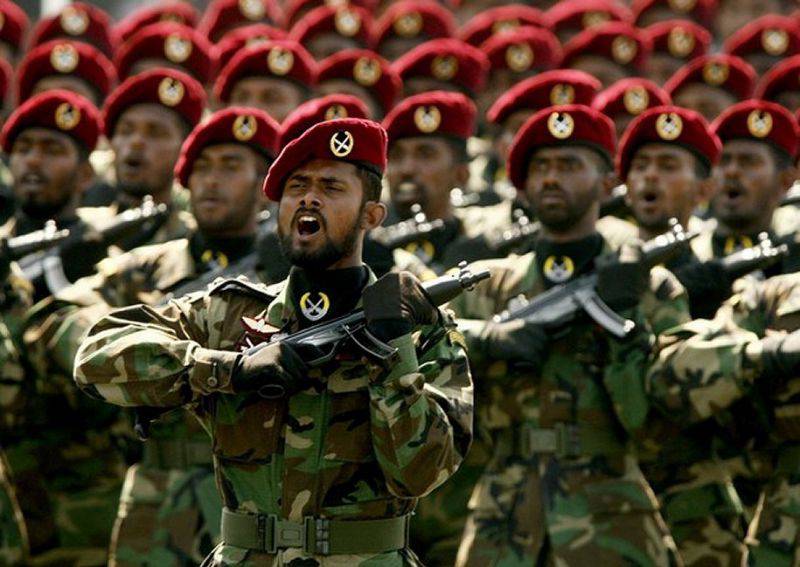
Information